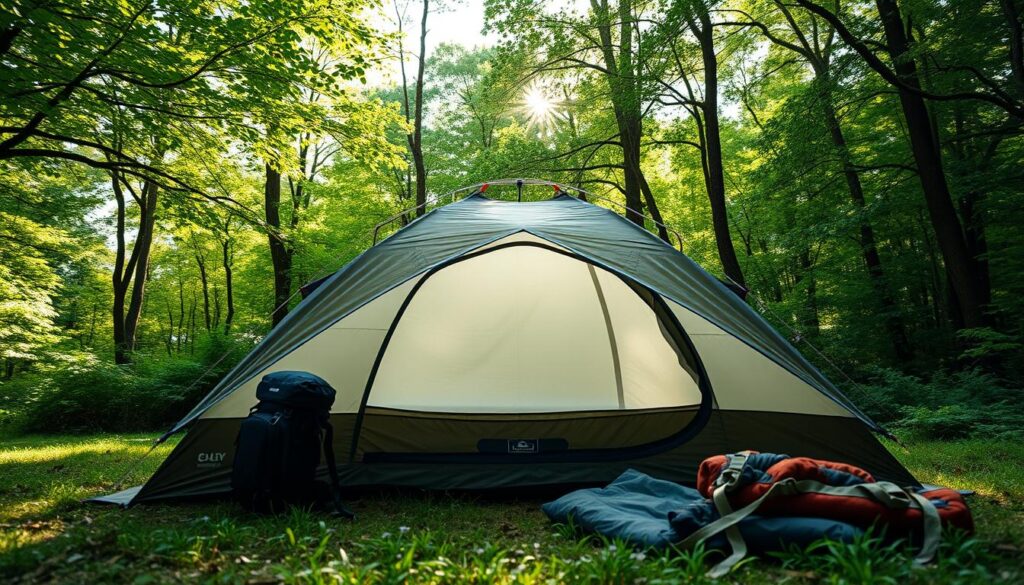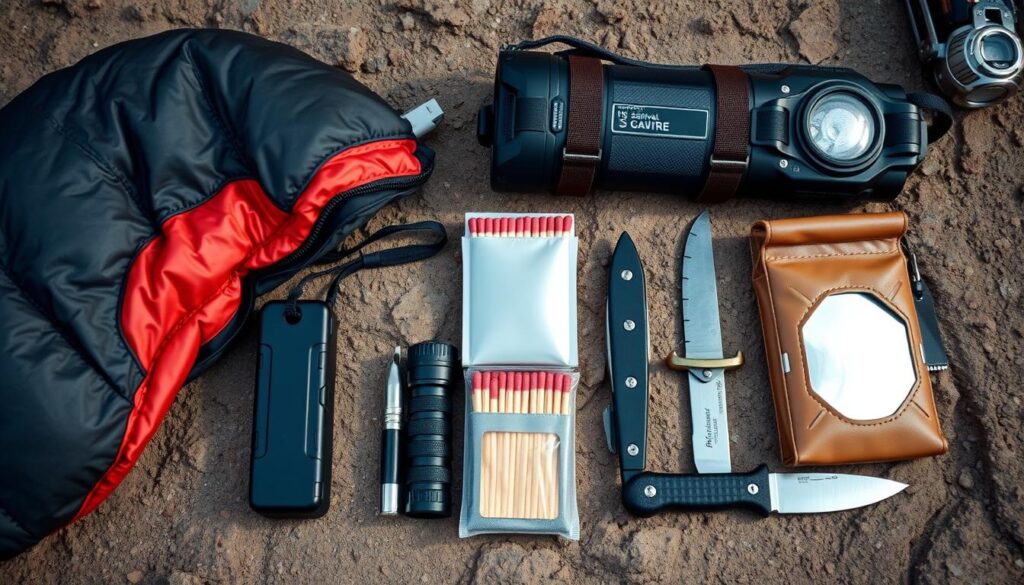I love the outdoors, but bad weather can ruin a trip. Being caught in a storm without a shelter is scary. That’s why I always carry a durable camping shelter. In this guide, I’ll show you how to set up a reliable emergency tent.
A lightweight emergency tent is key for outdoor adventures. It’s not just about having a tent. It’s about knowing how to use it right. I’ll guide you through setting up your emergency tent. This way, you’ll be ready for anything the outdoors brings.
Key Takeaways
- Understand the importance of a durable camping shelter in outdoor adventures.
- Learn how to choose the right lightweight emergency tent for your needs.
- Discover the essential steps for setting up your emergency tent.
- Gain insights into effectively using your emergency tent in unexpected situations.
- Be prepared for various weather conditions with the right gear.
What is a Lightweight Emergency Tent?
A lightweight emergency tent is a portable shelter for outdoor adventures. It protects you from the elements. Having one can be a lifesaver when you’re in the wilderness.
Defining the Concept
This type of tent is small, light, and easy to set up. It’s made of strong, waterproof materials. It’s meant to be a safe place in emergencies, like bad weather or injuries.
Key Features to Look For
When picking a lightweight emergency tent, look for these features:
- Material Durability: It should be made of tough, waterproof stuff.
- Weight and Size: It needs to be light and small for easy carrying.
- Ease of Setup: It should be simple to put up, even in tough conditions.
- Ventilation: Good airflow is key to avoid moisture inside the tent.
Keep these in mind to find a compact emergency tent that fits your needs.
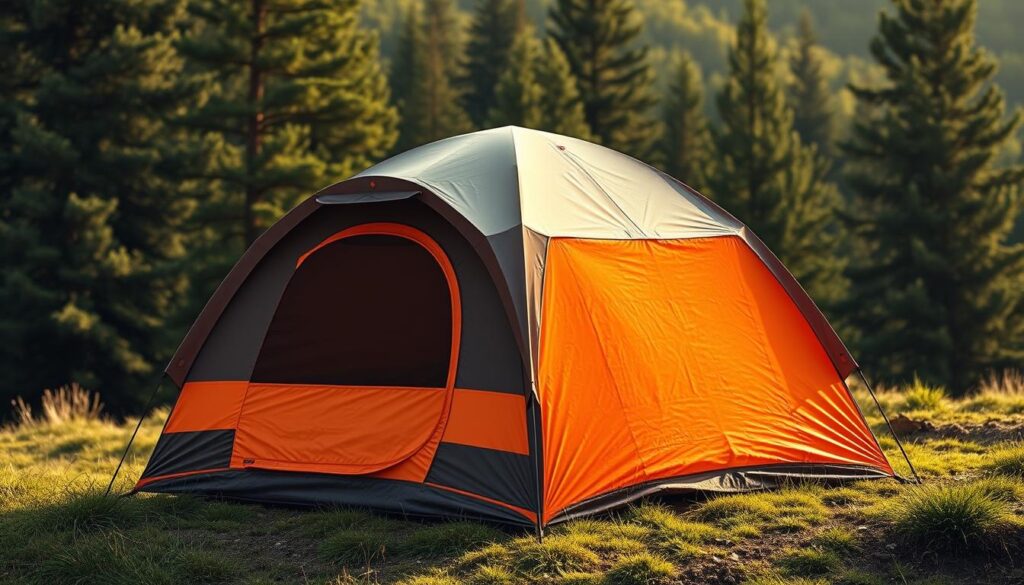
Why You Should Own One
A lightweight emergency tent is more than just a precaution; it’s a necessity for anyone who spends time outdoors. Whether you’re hiking, backpacking, or just enjoying a day in the wilderness, an emergency tent can provide critical protection. It’s perfect for unexpected overnight stays or severe weather.
Importance in Outdoor Safety
Outdoor adventures can quickly turn into survival situations without a reliable shelter. Unexpected weather events or injuries can make it vital to have a shelter. A weatherproof tent is designed to withstand harsh conditions, providing a safe haven. The importance of having such a tent cannot be overstated, as it can be a lifesaver in critical situations.
The table below highlights key scenarios where an emergency tent proves its worth:
| Situation | Risk Level | Benefit of Emergency Tent |
|---|---|---|
| Unexpected Overnight Stay | High | Provides shelter and protection |
| Severe Weather Conditions | High | Offers a safe haven from elements |
| Injuries or Accidents | High | Ensures a safe place to rest and recover |
Versatility for Various Situations
An emergency tent is not just for extreme situations; it’s also versatile enough for various outdoor activities. From hiking and backpacking to car camping, a lightweight emergency tent can be a valuable addition to your gear. It can serve as a backup shelter in case your primary tent fails or is damaged.
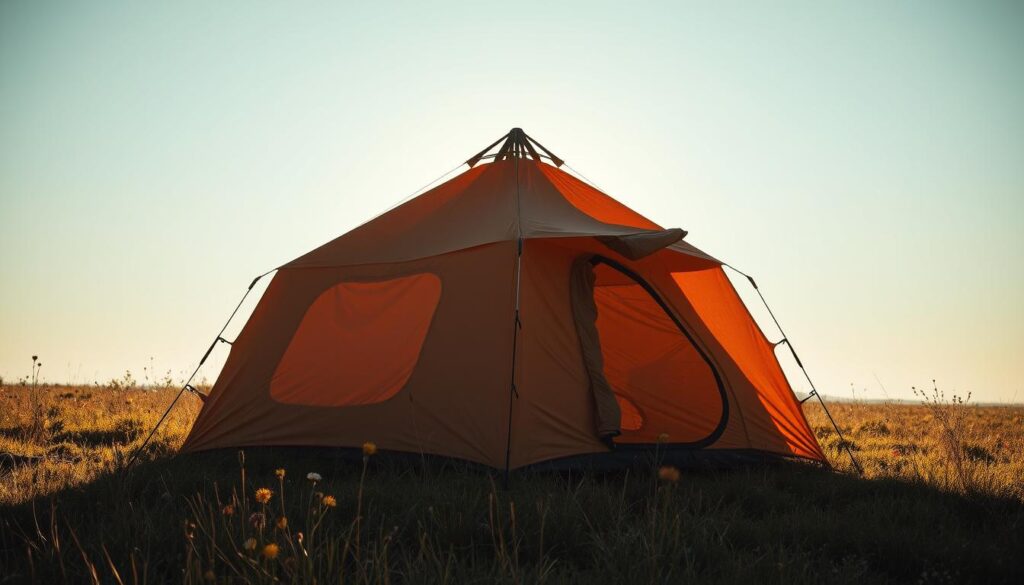
In conclusion, owning a lightweight emergency tent is essential for outdoor safety and preparedness. It offers a safeguard against the unpredictable nature of the outdoors, ensuring you’re always prepared for the worst-case scenario.
Choosing the Right Model
Choosing an emergency shelter for hiking involves several factors. As someone who loves the outdoors, I’ve found that the right shelter can be a lifesaver. It’s important to think about your needs, how many people it must hold, and the weather you’ll face.
Factors to Consider
When picking a lightweight emergency tent, consider a few key things. Weight and size matter a lot because you’ll carry it. Look for a tent that’s small and light but has enough room inside. The material and durability of the tent are also key; it should handle different weather well. Plus, the ease of setup is important, as you might need to set it up fast in tough conditions.
Think about how many people will use the tent. Some are for one person, while others can fit two or more. Also, the seasonality and weather resistance of the tent should match where you’ll use it. For example, if you’ll be hiking in cold winter weather, you need a tent that can handle snow and strong winds.
| Feature | Description | Importance Level |
|---|---|---|
| Weight and Size | Compact and lightweight | High |
| Material and Durability | Weather-resistant and sturdy | High |
| Ease of Setup | Quick and straightforward | Medium |
| Capacity | Number of occupants | High |
| Seasonality and Weather Resistance | Adaptability to various conditions | High |
Popular Brands to Explore
Many brands are known for their quality emergency shelters. MSR, Black Diamond, and REI Co-op are top choices. Look at their product lines, like MSR’s lightweight series or Black Diamond’s extreme weather tents.
“A good emergency shelter is not just about having a roof over your head; it’s about having a system that can keep you safe and relatively comfortable until help arrives or the weather passes.”
When looking at models, think about packed weight, setup ease, and interior space. For example, the MSR Elixir is a favorite for its design and weather resistance. By considering these factors and checking out popular brands, you can find the right shelter for your needs and feel safe on the trails.
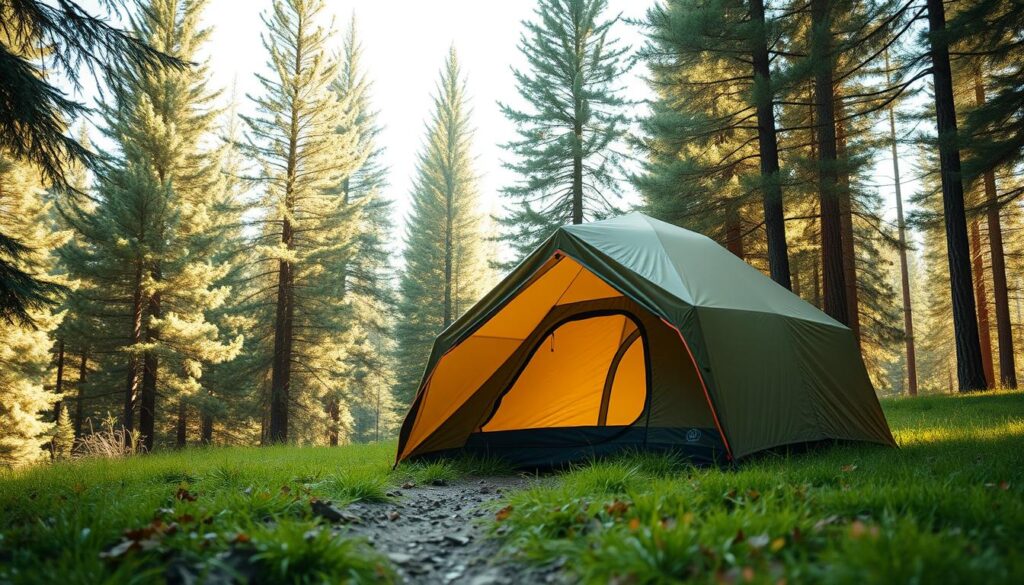
Essential Gear for Tent Setup
To set up a compact emergency tent right, you need the right tools. Having the essential gear ready can make a big difference. It helps you set up your tent quickly and securely.
Tent Stakes and Cordage
Tent stakes are key for keeping your ultralight tent for emergencies stable. The type of stake needed depends on the ground. For soft soil, use longer stakes. For hard ground, choose shorter, wider stakes.
Also, having the right cordage is important. Use durable twine or paracord to tie down your tent. This keeps it stable and secure.
Tarps and Ground Covers
Tarps and ground covers add extra protection against the weather. A tarp can serve as a makeshift shelter or protect your tent from rain or snow. Ground covers keep your tent’s floor dry and protect it from rough debris.
Multi-tools and Accessories
Multi-tools and accessories, like a repair kit, are very useful. A multi-tool can help with adjustments or repairs in the field. A repair kit with patching tape and spare cordage can fix any damage or tears.
For more tips on setting up a survival tent, check out this guide on tactical preparedness.
Step-by-Step Setup Instructions
Setting up your emergency tent right is key for safety in tough times. A good campsite is the base of a safe shelter.
Preparing the Campsite
First, pick a good spot for your tent. Look for a flat, dry area that’s away from water. Make sure it’s not near standing water or where water might collect.
Clear the area of rocks, twigs, and debris. These can harm your tent or make it hard to stay inside.
After picking your spot, clean the ground. Remove sharp objects and plants that could hurt your tent. If needed, use a tarp or leaves to protect the ground from your tent.
Assembling the Tent
To set up your portable survival tent, unpack and organize everything. This includes the tent, poles, rain fly, stakes, and cordage. Always follow the maker’s guide for how to put it together, as each tent is different.
Start by attaching the poles to the tent. Make sure they’re locked in place. Then, stand the tent up.
Next, add the rain fly for extra protection. Make sure it’s tight to keep out wind and water.
Securing the Tent Properly
To keep your tent weatherproof, secure it well. Use stakes to tie it to the ground. Make sure they’re in at an angle for better grip. Tighten the cordage to remove any slack.
Check that the tent fabric is tight and even. This helps keep it stable.
“A tent that’s not properly secured is as good as no tent at all in harsh weather conditions.”
Lastly, check if your tent is stable and ready. Look for any weak spots or issues that could affect its safety.
Tips for an Effective Experience
Getting the most out of an emergency tent needs some insider tips. With the right advice, you can greatly improve your experience.
Maximizing Space Inside the Tent
To use the space in your durable camping shelter well, organize your gear smartly. Keep your gear tidy and easy to find. Use storage nets or pockets to keep important items off the floor.
This helps keep the tent clean and makes it feel bigger. Plan out your tent’s layout. Set up areas for sleeping, storing things, and even a small hygiene spot. This way, you’ll stay comfortable and focused during your stay.
Weather Considerations to Keep in Mind
Knowing the weather is key when using an emergency shelter for hiking. Always check the forecast before you go. Be ready for sudden weather changes.
Learn how to secure your tent against wind and rain. Using the right stakes and pitching it tight can help a lot. If the weather gets bad, it’s important to know when to stay inside and wait for it to pass.
For more detailed advice on setting up an emergency shelter, check out this guide on crafting an emergency shelter.
Maintenance and Care of Your Tent
To keep your emergency tent in top shape, regular care is key. Proper maintenance extends its life and makes sure it’s ready when you need it. This is true for any ultralight tent for emergencies.
Cleaning Methods
Cleaning your tent often is important to stop dirt and grime buildup. A simple wipe with a damp cloth usually does the trick. For deeper cleaning, a mild soap solution works well. But, stay away from harsh chemicals that can harm the waterproof coating.
After cleaning, make sure to thoroughly dry the tent to avoid mildew. Mildew can weaken the fabric and make the tent less reliable. If mildew appears, use a soft-bristled brush to gently remove it, then clean and dry the area.
Storage Tips for Longevity
Storing your tent right is as important as cleaning it. Keep it in a dry, cool spot, away from sunlight. Sunlight can damage the fabric over time. Store the tent loosely to let air circulate and prevent moisture buildup.
| Storage Method | Benefits |
|---|---|
| Loose Packing | Prevents moisture buildup |
| Cool, Dry Place | Reduces risk of mildew |
| Avoid Direct Sunlight | Prevents fabric degradation |
By following these easy maintenance and care tips, you can make your ultralight tent for emergencies last longer. Regular care means your tent will always be ready to provide shelter when you need it.
Real-Life Scenarios for Use
When you’re in the wilderness, a compact emergency tent can save your life. A portable survival tent is a must-have for anyone who loves the outdoors.
A lightweight emergency tent is more than just a piece of gear. It’s a safety net that keeps you dry and warm when you least expect it. Whether you’re hiking or backpacking, having a good shelter can mean the difference between a great adventure and a disaster.
Hiking and Backpacking
For those who love to hike and backpack, a compact emergency tent is a must-have. It keeps you safe from bad weather. When a storm hits or it gets dark, this tent is your safe place, protecting you from wind, rain, and animals.
- Reliable shelter in case of bad weather
- Protection from wildlife
- A safe haven for rest
Emergency Preparedness at Home
A portable survival tent is also great for emergency preparedness at home. It’s a lifesaver during natural disasters like hurricanes, earthquakes, or floods. It gives you and your family a safe place to stay.
In emergencies where you can’t leave, a compact emergency tent offers hope. It gives you a sense of safety and comfort. It shows that even in tough times, there are ways to stay safe and recover.
Conclusion: Getting the Most from Your Lightweight Emergency Tent
A lightweight emergency tent is key for outdoor lovers. It gives a safe place when you least expect it. Knowing how to pick, set up, and care for your tent is important.
Buying a good emergency tent is smart for anyone who loves the outdoors. It keeps you safe from bad weather and gives you peace of mind.
Many experts agree: having the right gear, like a good emergency tent, is essential. This guide has covered the main points. Now, it’s time to get a quality tent that fits your needs.
In short, a well-picked emergency tent is a lifesaver. It keeps you safe in tough times. It’s a must-have for your outdoor safety kit.
FAQ
What is the primary purpose of a lightweight emergency tent?
A lightweight emergency tent offers shelter and protection. It’s for unexpected overnight stays or bad weather during outdoor adventures.
What are the key features to look for in a lightweight emergency tent?
Look for durability, light weight, and size. Also, check the ventilation. These ensure the tent is safe and comfortable.
How do I choose the right emergency tent for my needs?
Think about how many people it needs to hold. Consider the places you go and what you need most.
What are some essential accessories needed for setting up an emergency tent?
You’ll need stakes, cordage, tarps, and multi-tools. These help set up the tent fast and securely.
How do I properly set up my emergency tent?
First, prepare your campsite. Then, assemble and secure the tent. Follow a guide for stability and to keep it dry.
How can I maximize the space inside my emergency tent?
Organize your gear well. Keep the inside cozy. And watch the weather to stay safe and comfy.
What are the best practices for maintaining my emergency tent?
Clean it right, dry it well, and store it properly. This prevents damage and keeps it lasting longer.
Can emergency tents be used in scenarios other than backpacking or hiking?
Yes, they’re versatile. You can use them for outdoor fun and even for home emergencies.
What are some popular brands for lightweight emergency tents?
Look into brands known for quality and durability. They’re often praised by outdoor enthusiasts.
How do I ensure my emergency tent remains in good condition when not in use?
Store it right and follow maintenance tips. This keeps it ready for when you need it again.

